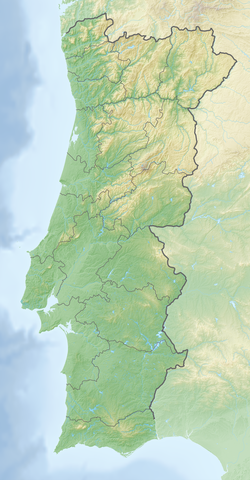
Back Elvas AN الواس Arabic الواس ARZ Элваш Byelorussian Elvas Breton Elvas Catalan Элваш CE Elvas (munisipyo) CEB Elvas Czech Elvas German
You can help expand this article with text translated from the corresponding article in Portuguese. (October 2012) Click [show] for important translation instructions.
|
Elvas | |
|---|---|
 | |
| Coordinates: 38°52′N 7°09′W / 38.867°N 7.150°W | |
| Country | |
| Region | Alentejo |
| Intermunic. comm. | Alto Alentejo |
| District | Portalegre |
| Parishes | 7 |
| Government | |
| • President | José António Rondão Almeida (PS) |
| Area | |
| • Total | 631.29 km2 (243.74 sq mi) |
| Population (2011) | |
| • Total | 23,078 |
| • Density | 37/km2 (95/sq mi) |
| Time zone | UTC+00:00 (WET) |
| • Summer (DST) | UTC+01:00 (WEST) |
| Local holiday | January 14 |
| Website | http://www.cm-elvas.pt |
| UNESCO World Heritage Site | |
|---|---|
 Walls and fortifications of Elvas | |
| Official name | Garrison Border Town of Elvas and its Fortifications |
| Location | Elvas, Portalegre District, Alentejo, Portugal |
| Criteria | Cultural: (iv) |
| Reference | 1367bis |
| Inscription | 2012 (36th Session) |
| Extensions | 2013 |
| Area | 179.356 ha (443.20 acres) |
| Buffer zone | 690 ha (1,700 acres) |
| Coordinates | 38°52′50.23″N 7°9′47.96″W / 38.8806194°N 7.1633222°W |
Elvas (Portuguese pronunciation: [ˈɛlvɐʃ] ) is a Portuguese municipality, former episcopal city and frontier fortress of easternmost central Portugal, located in the district of Portalegre in Alentejo. It is situated about 200 kilometres (120 mi) east of Lisbon, and about 8 kilometres (5.0 mi) west of the Spanish fortress of Badajoz, by the Madrid-Badajoz-Lisbon railway. The municipality population as of 2011[update] was 23,078,[1] in an area of 631.29 square kilometres (243.74 sq mi).[2] The city itself had a population of 16,640 as of 2011[update].[3]
Elvas is among the finest examples of intensive usage of the trace italienne (star fort) in military architecture, and has been a World Heritage Site since 30 June 2012. The inscribed site name is Garrison Border Town of Elvas and its Fortifications.
- ^ Instituto Nacional de Estatística
- ^ "Áreas das freguesias, concelhos, distritos e país". Archived from the original on 2018-11-05. Retrieved 2018-11-05.
- ^ UMA POPULAÇÃO QUE SE URBANIZA, Uma avaliação recente – Cidades, 2004 Archived October 6, 2014, at the Wayback Machine Nuno Pires Soares, Instituto Geográfico Português (Geographic Institute of Portugal)









